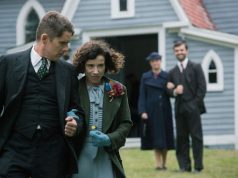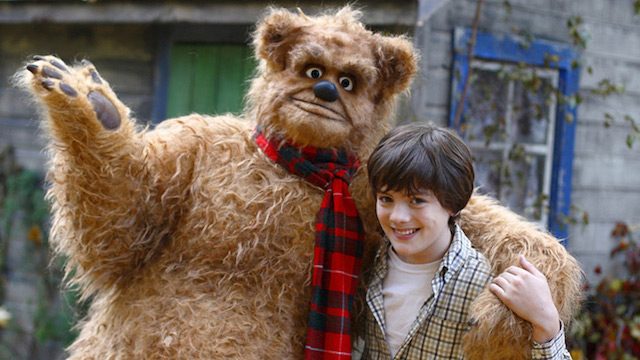
Canada is a magical, faraway land that few people have ever seen. Some scholars believe is mythical, like Narnia. The “Canadians,” as they are known, have many fantastical customs, such as putting the letter “u” in words that don’t need it, and eating ketchup-flavored potato chips, and letting the queen be on their money. Things are so quaint and unusual in Canada, so it is said, that when someone up there makes a movie about an 11-year-old boy who is befriended by a talking bear with the voice of a grown man — whom he keeps hidden from his family, and with whom he is frequently alone — no one bats an eye. No one thinks, “Hmm, that’s creepy.” Instead they think, “What a jolly and charming family film for us to show to impressionable children, to teach them the value in making friends with weird, mysterious strangers!”

Ladies and gentlemen, I give you “Gooby,” a real movie that was really made by real Canadians, including a writer/director/producer named — for real — Wilson Coneybeare. “You are crapping us!” you say. “‘Wilson Coneybeare’ is a silly name that you made up because it sounds like the name of someone who would make a surreal movie about a boy and his bear friend!” But I am not crapping you. I don’t even know what that word means in that context. His name is Wilson Coneybeare, and he made “Gooby,” and he was serious when he did it.
The boy in “Gooby” is named Willy. (This does not help matters.) His parents and teachers say he has an overactive imagination — “but I just see things grown-ups don’t,” he tells us in the narration, because I guess having unwilling hallucinations is better than making things up on purpose. Among the things he sees that adults don’t see (because they don’t exist) are “hoonies,” which are large, blue, two-headed monsters that want to eat him. Willy hallucinates a lot of beasts like this, and consequently is afraid of everything all the time. (When you live in Canada, where nothing is scary, you have to make up things to be afraid of.) To ward off the evils of his own imagination, Willy has a bunch of good-luck charms and amulets, whose protection, being equally imaginary, cancels out the imaginary danger. Or something. Look, I don’t understand how this kid’s psychosis works.
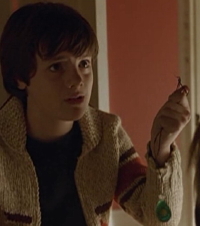
Willy’s already-precarious mental health is further compromised when his parents move to a new house in a different neighborhood. For companionship, his mom suggests he take along Gooby, his old teddy bear, but Willy dismisses this option as too childish. He’d prefer to conjure up two-headed monsters that live under his bed, thank you very much, the way non-children do. Terrified of the new house and everything associated with it, Willy prays to one of his good-luck charms for help in not being afraid. This causes Gooby, abandoned at the old house, to come to life, grow to a height of six feet, and show up at the new house. Now, believe it or not, when Willy asked his amulet for protection from scary things, he was NOT expecting a discarded toy to become sentient and materialize before him. I don’t know how this fits in with his theology, or with Canadian Amuletism in general.

Gooby does not look like a real bear. Nor does he look like an enlarged teddy bear. He looks like a man in a bear costume, and not a bear costume that cost very much money, either. More specifically, he looks like the man in a bear costume who is briefly seen engaged in adult situations with another man in “The Shining.” He also looks like John Candy in “Spaceballs.” He also looks like Sen. Fred Thompson. He has an unnecessarily wide mouth and sparse, Chiclet-shaped teeth, like a hillbilly in a cartoon about moonshiners. He has the voice of Robbie Coltrane, who also plays Hagrid in the Harry Potter movies — who is also, now that we think about it, on the creepy end of the loner-who-lives-in-the-woods-and-spends-all-his-time-with-children scale.
Gooby is a friendly and playful sort, and after the initial shock wears off, Willy is happy to have him for a friend. Any port in a storm, I guess, even a port that is vaguely nightmarish and entirely nude except for a scarf. (YOU ARE NOT HELPING YOUR CASE, MOVIE.) Gooby and Willy scamper and play. In one scene, they throw hot dogs at each other, then burp and fart, as one does. Gooby is a fun playmate, though it turns out he’s afraid of even more things than Willy is, so he’s not much help in that department. Which you’ll recall is the specific department in which his services were requested. Gooby is like a prostitute who just makes you feel lonelier. Or maybe the Canadian Amulet deity who sent Gooby has done this on purpose, to teach Willy to be brave on his own. Who am I to question the wisdom of the Canadian Amulet deity?
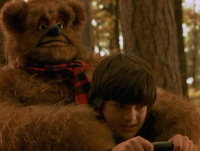
Sensing the shame inherent in the situation, Willy assumes he should hide Gooby from everyone. He seems to know that his parents would not approve of his friendship with a living teddy bear. Perhaps they have already made their prejudices known. Perhaps that’s why they moved in the first place, because too many anthropomorphic playthings were moving into the old neighborhood. Whatever the reason, Gooby is kept hidden from the world. Except for when he isn’t. Like when Gooby and Willy ride a go-kart down a steep hill and soar across a busy highway, for example, causing passing motorists to stop and gape. Willy was afraid to try this, but he winds up enjoying it. “In the end, it was great because I’d been scared at first!” he says, one of several lines that will surely appear in the court transcript.

Among the people who saw Gooby and Willy fly over the street on a go-kart is Willy’s teacher. He is very nerdy, and his name is Mr. Nerdlinger. (“Excuse me, Mr. Coneybeare … Is that the final revision on the teacher’s name? Yeah? It is? OK.”) Mr. Nerdlinger is played by Eugene Levy, who, as a Canadian citizen, is compelled by birthright to appear in any Canadian film that requests him. Mr. Nerdlinger thinks that getting a photograph of this big bear-man would make him famous. After this, whenever Gooby wanders out in public — which is often — Mr. Nerdlinger always happens to be there, too, and always juuuust misses getting his camera out in time. Gooby even follows Willy and his mom to the supermarket one day, somehow managing to stay hidden from everyone in the place except for Willy and Mr. Nerdlinger.
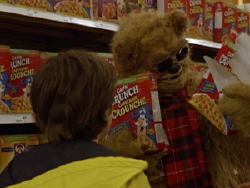
The important thing about the supermarket scene is that it shows us what Cap’n Crunch is called in Canada: “Capitaine Crounche.”
Tiring of his half-hearted and unsuccessful efforts to keep Gooby hidden, Willy is relieved when Halloween arrives. Now Gooby can walk around freely and people will think it’s just someone in a costume! (Of course, we were already thinking that, but you know what I mean.) Gooby and Willy go to the movies, where Gooby helps Willy score points with the cool kids from school by pretending to be his dad so they can all get into an R-rated movie. Afterward, they have this conversation:
GOOBY: You know, I really kind of liked that.
WILLY: Liked what?
GOOBY: Being your dad.
Seriously, Gooby couldn’t be creepier if he were a bicycle-shop owner played by Gordon Jump.
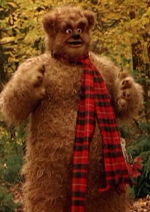
The more unsettling the film becomes, the less aware it is that it’s unsettling at all. This is a rare skill. Soon Gooby leads Willy into the woods. “I’ve got to show you something!” he says excitedly. “It’s a secret. Do you trust me?” In narration, Willy says, “This was a journey that was going to change me forever,” and SWEET CANADIAN AMULET DEITY ALMIGHTY DID NO ONE READ THIS SCRIPT BEFORE THEY FILMED IT?!
What Gooby wants to show Willy is the ramshackle house Willy’s dad grew up in, which apparently is within walking distance of his current residence. Willy’s dad is a workaholic who must be taught a valuable lesson. He learns this lesson when Willy falls through the floorboards of his childhood home and gets stuck, and Gooby calls Dad on Willy’s cell phone, and Dad hurries over to free Willy. It turns out that the movie’s agenda all along was to encourage parents to spend more time with their children. Yes, it’s just another flagrant piece of “spend more time with your children” propaganda from Canadian Hollywood (Houlywooud).
Without changing the script at all, you could remake “Gooby” as a spine-tingling cautionary tale. An only child whose parents don’t have time for him cries desperately to pagan gods for help and is visited by a middle-aged man in a bear costume who wants to be his secret — and only — friend. A concerned school teacher tries to capture photographic evidence of the bear-man but is thwarted at every turn. At last the bear-man takes the boy to a condemned house, whereupon the boy is injured and his father must rescue him, finally repenting of his neglectful ways and banishing the bear-man from their lives forever … or at least until he returns, in “Gooby II: Electric Goobaloo.”
https://www.youtube.com/watch?v=ErcxDqhq0aA
— Film.com




